With the flowering of the Renaissance in Europe came a desire to understand more of 'God's Kingdom'. Prior to this period, nature was regarded by Europeans almost entirely as something to be overcome or utilized; survival was the order of the day. In the 13th-century work De Natura Animalium, by Albertus Magnus, butterflies were described simply as 'flying worms', with no eye to their beauty. The development of printing enabled information to be more widely disseminated, which in turn promoted a greater interest in natural history. It is fascinating to trace chronologically the publication of works in which mention is made of hawkmoth species within the region covered by this work -- a period which spans four centuries.
The first English work in which hawkmoths were recognizably described was Insectorum sive Minimorum Animalium Theatrum by Thomas Mouffet. Although completed in 1589, it was not published until 1634 -- thirty years after Mouffet's death -- at the expense of Sir Theodore de Mayerne, one of the royal physicians. A number of butterflies, moths and their caterpillars were given names of which one, Porcellus, was used by Linnaeus (1758) for Deilephila porcellus when describing both adult and larva. The work proved so popular that an English edition was published in 1658 as part of a larger work incorporating Edward Topsell's The History of Four-footed Beasts and Serpents.
J. Hoefnagel, in parts 1--4 of Archetypa Studiaque Patris (1592), illustrated adults and larvae of Agrius convolvuli, Acherontia atropos, Smerinthus ocellatus, Laothoe populi, Macroglossum stellatarum and Hyles euphorbiae; there was no text. The illustrations in the book were uncoloured, but a copy at the Natural History Museum, London, has been coloured by a contemporary hand.
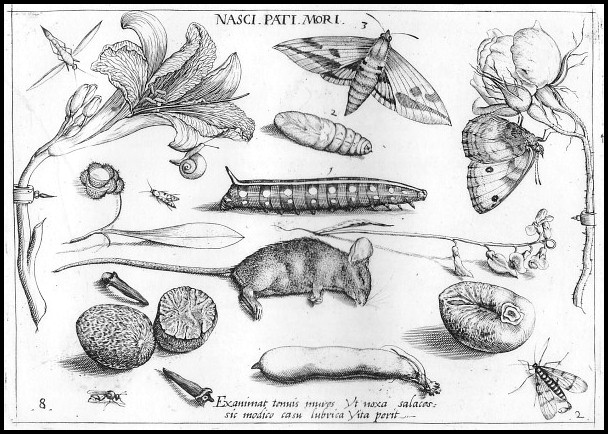
In 1638, V. Aldrovandus published the second edition of De Animalibus Insectis Libri Septem, which contained recognizable monochrome drawings of the pupa of Agrius convolvuli, the larvae of Acherontia atropos and Hyles euphorbiae, and the adult of Macroglossum stellatarum, all species which must have occurred in his native Bologna, Italy.
Although more famous for her spectacular work De Metamorphosis Insectorum Surinamensium (1705), Maria Sibylla Merian also produced a similar and earlier work on European Lepidoptera, first published in German as Der Raupen wunderbare Verwandelung (1679). A second volume, which appeared four years after the first in 1683, contained fine copperplate illustrations of eight European hawkmoths with hostplants, namely Agrius convolvuli, Sphinx ligustri, Mimas tiliae, Smerinthus ocellatus, Laothoe populi, Macroglossum stellatarum, Hyles euphorbiae and Deilephila elpenor. The text makes clear her powers of observation and interest in insect metamorphosis. Maria Merian was so fascinated by the parasites which developed from the caterpillars she collected that she also illustrated and described many of them. The plate of Smerinthus ocellatus shows quite clearly the cocoons and adults of Microplitis ocellatae; the tachinid Masicera sphingivora, or a closely related species, is depicted on the plate of Hyles euphorbiae. Dutch, Latin and French editions of this work were also published between 1713 and 1730.
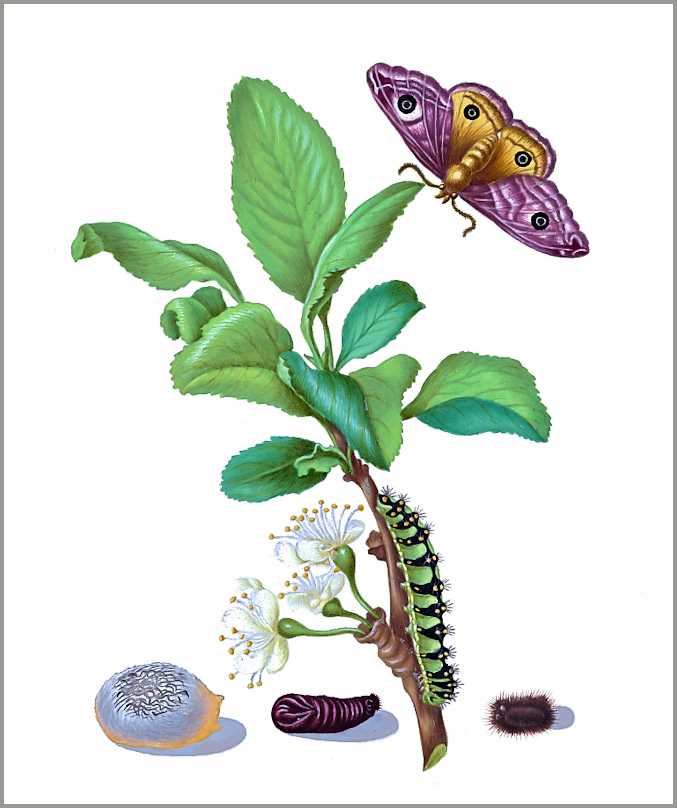
Johann Jacob Swammerdamm, in Historia Insectorum generalis (1669), later translated into English as The Book of Nature; or, the History of Insects (1758), described the adult, larva and pupa of Agrius convolvuli, which he called 'Pernix'. In the English edition, this species, which he states was originally described by John Bauhinius in 1693 in his treatise on 'hurtful winged animals', is easily recognized from the uncoloured line engraving.
John Ray, in Historia Insectorum published posthumously in 1710, described the biology and morphology of the larvae and adults of several British species, of which only Sphinx ligustri and Deilephila porcellus are recognizable from the text; there were no plates.
Eleazar Albin, in A Natural History of English Insects (1720), described the ecology and morphology and listed the hostplants of six sphingid species found in England, depicting in the fine colour plates their complete life cycles and hostplants. One plate -- that of Deilephila elpenor -- even illustrated the parasite Amblyjoppa proteus; another yellow-and-black ichneumonid is depicted on the plate illustrating Sphinx ligustri. He also wrote of larvae of Mimas tiliae being so numerous as to constitute a pest of lime trees (Tilia), and stated correctly that the larva of Deilephila elpenor could swim. It appears probable from the similarity of the species of hawkmoths selected and the nature of their depictions that Benjamin Wilkes, James Dutfield and Moses Harris all borrowed freely from this beautiful work in preparing their own plates.
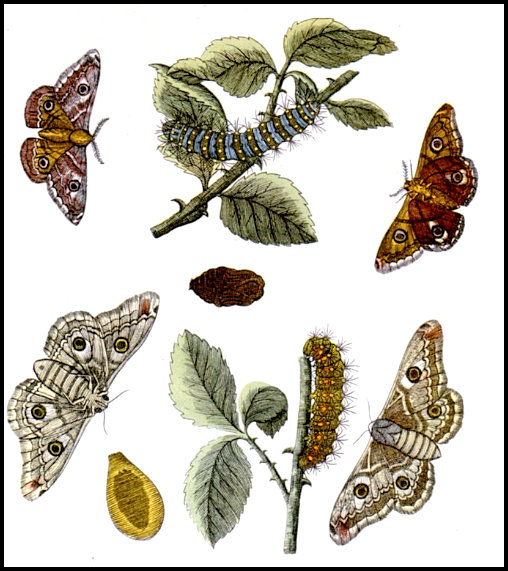
Jacob L'Admiral, in Naauwkeurige Waarneemingen van Veele Gestaltverwisselende Gekorvene Diertjer (1740), illustrated and described the ecology and biology of two European hawkmoths, Smerinthus ocellatus and Laothoe populi, and also listed their hostplants. It was republished in 1774, after the artist's death, as Naauwkeurige Waarneemingen Omtrent de Veranderingen van Veele Insekten.
Benjamin Wilkes, in Twelve new designs of English butterflies (1742), depicted seven hawkmoths found in Britain, arranged geometrically with other moths and butterflies in his twelve plates (Acherontia atropos, Sphinx ligustri, Mimas tiliae, Smerinthus ocellatus, Laothoe populi, Deilephila elpenor and Deilephila porcellus). The captions to each provided information on the time of emergence, hostplants and occurrence of the caterpillar, of which four were depicted on the title-page (Acherontia atropos, Sphinx ligustri, Laothoe populi and Deilephila elpenor). The English names for each species are almost the same as those in use today. Wilkes' more ambitious English moths and butterflies [1749] contained descriptions of the ecology, morphology and hostplants of eight British species of hawkmoths, with good colour plates of their complete life-cycles on the hostplants. Like Albin, he depicted the ichneumonid Amblyjoppa proteus on the plate of Deilephila elpenor. The work ran to three editions of which the last, incorporating Linnaean nomenclature, was published in 1824.
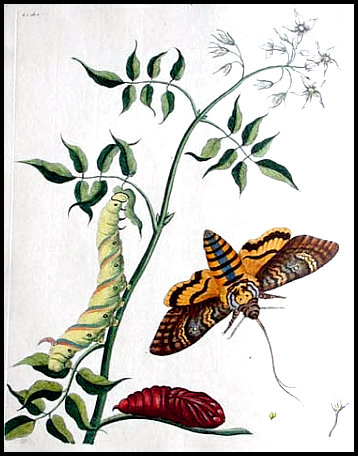
August Johann Roesel von Rosenhof, in Vols I, III and IV of the four-volume work, Insecten Belustigung ([1746]--61), provided the biology, hostplants and descriptions of fifteen central European species. Good colour plates depicted both larvae and adults. He died before the publication of the fourth volume which was completed by Christian Friedrich Carl Kleeman.
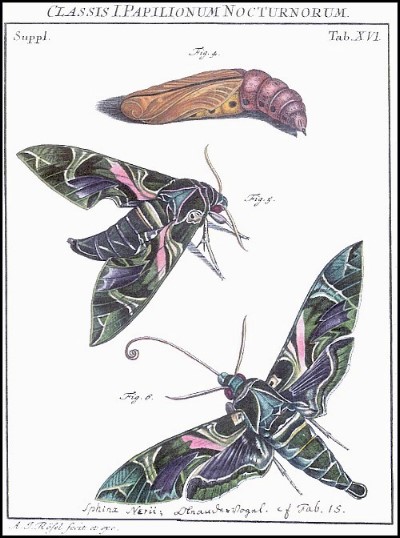
During 1748--49, James Dutfield started on the publication of A new and complete Natural History of English Moths and Butterflies but only six parts are known and probably no more were issued. Several species of hawkmoths were illustrated and described. Similarities between these plates and those of Eleazer Albin suggest that Dutfield plagiarized Albin's work.
Carl DeGeer, in the first two volumes of Memoires pour servir a l'Histoire des Insectes (1752, 1771), described the biology and hostplants of seven species found in Sweden, with uncoloured plates of larvae and adults of Hyloicus pinastri, Deilephila elpenor, Hyles gallii, Laothoe populi and Sphinx ligustri in Volume I, and of Mimas tiliae and Smerinthus ocellatus in Volume II.
Until this time, species illustrated and described had been given vernacular names, many of which survive to this day. Rene Antoine Ferchault de Reaumur had been the first to use the word 'Sphinx' in 1736, in reference to the larva of Sphinx ligustri, a name which Linnaeus, on page 248 of the first edition of Fauna Suecica (1746), retained for this species. That edition of Fauna Suecica did not contain binominal nomenclature but, with the publication of the tenth edition of Systema Naturae in 1758, Linnaeus applied his Latin binominal system to the animal kingdom, which contains the Lepidoptera. He selected Reaumur's name Sphinx as the generic name for all the hawkmoths but gave each a trivial or specific name. Sixteen European sphingid species were included in this category, as were several of the Zygaenidae and Sesiidae -- an association which was maintained, at least in part, for about 100 years until Butler (1876) removed all remaining species of these families from the Sphingidae. It is interesting to note that Linnaeus had first adopted a short binominal system in 1745 in the index to a travel book, and used it again in 1749 as a shorthand when referring to Swedish plants. In 1753 he applied the binominal system to the plant kingdom in his Species Plantarum. The concept of a uniform system of classification was not new, but Linnaeus was the first person to apply it universally (Usinger, 1964).
Nicolaus Poda von Neuhaus, in Insecta Musei Graecensis (1761), adopted the Linnaean system to name and describe the adults of eight central European sphingid species, as well as providing information on their distribution and hostplants. He included an uncoloured engraving of Hemaris fuciformis but, like many early authors, he confused this species with Hemaris tityus.
The father and son team of Christian and Jan Christiaan Sepp, in the first four volumes of De Nederlandsche Insekten (1762--1811), described the biology and ecology and gave hostplants for twelve species found in the Netherlands. Superb colour plates depicted the complete life-cycles of most of these. Binominal as well as Dutch names were given for all species but, like many of their contemporaries, they treated Hemaris tityus and Hemaris fuciformis as one species. After the death of Jan Christiaan in 1811, the work continued to be published by two further generations of the Sepp family, until the death of Jan Christiaan's grandson, Cornelis Sepp in 1868. In all, they illustrated 18 species of european hawkmoths, namely Agrius convolvuli, Acherontia atropos, Sphinx ligustri, Hyloicus pinastri, Mimas tiliae, Smerinthus ocellatus, Laothoe populi, Hemaris fuciformis, Hemaris tityus (larva), Macroglossum stellatarum, Proserpinus proserpina, Daphnis nerii, Hyles euphorbiae, Hyles gallii, Hyles livornica, Deilephila elpenor, Deilephila porcellus and Hippotion celerio (larva).
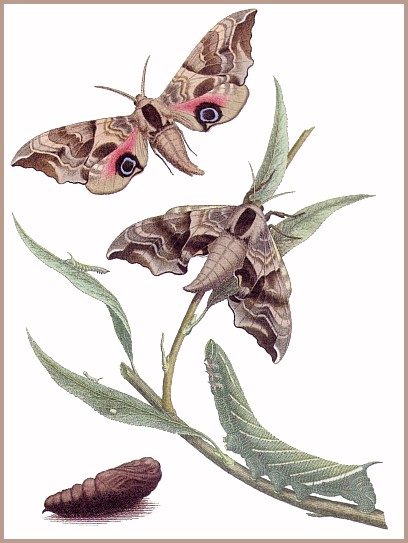
Johann Anton Scopoli included no plates in his Entomologia Carniolica (1763), but gave the distribution, adult morphology and hostplants of eleven central European species 'methodo Linneana', although also confusing Hemaris fuciformis with Hemaris tityus.
In 1766, Moses Harris published The Aurelian: Or, Natural History of English Insects; Namely Moths and Butterflies, a magnificent work, with 41 beautiful colour plates which included the ecology, descriptions, life cycles and hostplants of nine hawkmoths he had found in England. Following Albin and Wilkes, Harris also depicted the parasite Amblyjoppa proteus on the plate of Deilephila elpenor. In 1775, he published the first pocket guide to Lepidoptera entitled The English Lepidoptera: Or, The Aurelian's Pocket Companion. In tabular form, it listed numerous species of butterflies and moths by their common names, including eleven hawkmoths. Where known, hostplants, dates of occurrence, habitats, descriptions and Linnaean names were given. Unfortunately, no plates were included.
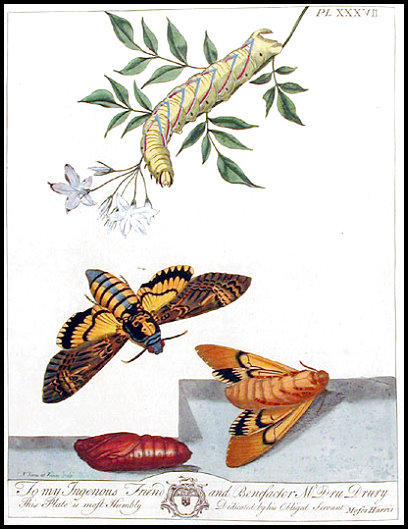
Johann Christian Fabricius, in Systema Entomologiae (1775), escribed fifteen European hawkmoth species. He split up Linnaeus' Sphinges into three distinct subgroups, namely Sphinx, Sesia (in which he included the Macroglossum and Hemaris) and Zygaena.
J. J. Ernst, in Volume III of his seven-volume work, Papillons d'Europe peints d'apres Nature (1779--1793), described the biology and listed the hostplants of 20 European species, including Marumba quercus and Hyles vespertilio.
Etienne Louis Geoffroy, in the second volume of Histoire abregee des Insectes (1799), dealt with aspects of ecology and the hostplants and morphology of nine species found in France, but with a poor colour illustration of only one, Macroglossum stellatarum.
Pierre Andre Latreille ([1802]), in Sonnini's edition of Buffon's Histoire Naturelle, proposed the name Sphingides for the whole group based on Linnaeus' original group Sphinges. It is from this term that the modern family name Sphingidae is derived.
In 1837, Volume 1 of Illustrations of Exotic Entomology was published. This work by Dru Drury had originally appeared in three volumes which were issued between 1770 and 1772, entitled Illustrations of Natural History. Although it dealt mainly with tropical moths and butterflies, the British status of Hyles euphorbiae and Hyloicus pinastri was discussed. It was stated that the former was rare in Devon, but that larvae could sometimes be common on Euphorbia paralias at Braunton Burrows and Barnstaple; it was plentiful in 1814. Hyloicus pinastri was recorded as being but a rare vagrant to England and Scotland.
By the end of the first half of the nineteenth century, the binominal system of nomenclature with recognizable genera and species had become firmly established and the first regional faunal works began to appear. One of the best of these was Fauna Lepidopterologica Volgo-Uralensis (1844) by Eduard Eversmann, in which the distribution of twenty species of hawkmoths found in the European part of Russia was recorded.
Since 1850, many other works have appeared on some or all of the Sphingidae of the whole of the western Palaearctic region or of its parts -- Europe, individual countries, or even smaller areas. These are too numerous to list here in their entirety but the following are those which have been most frequently consulted in the preparation of this work, especially with regard to distribution maps. Authors, with date of publication only, are given, divided according to their regional coverage; the full titles of the works will be found in the reference section. It should be noted that many references also give details of distribution beyond the region under which they are cited.
GENERAL: Rothschild W. & Jordan, K. (1903); Carcasson, R. H. (1968); Hodges, R. W. (1971); Fletcher, D. S. & Nye, I. W. B. (1982); D'Abrera, B. (1986).
WESTERN PALAEARCTIC: Hofmann, E. (1893, 1894); Staudinger, O. & Rebel, H. (1901); Kuznetsov, N. Ya. (1906); Jordan, K. (1912); Denso, P. (1913b); Gehlen, B. (1932b); Holik, O. (1948); Pittaway, A. R. (1983b, 1993).
EUROPE & NORTH AFRICA: Roueast, G. (1883); Hofmann, E. (1893, 1894); Tutt, J. W. (1902, 1904); Kirby, W. F. (1903, 1907); Spuler, A. (1908); Newman, L. H. (1965); Rougeot, P.-C. & Viette, P. (1978); Sokoloff, P. (1984); Freina, J. J. de & Witt, T. J. (1987).
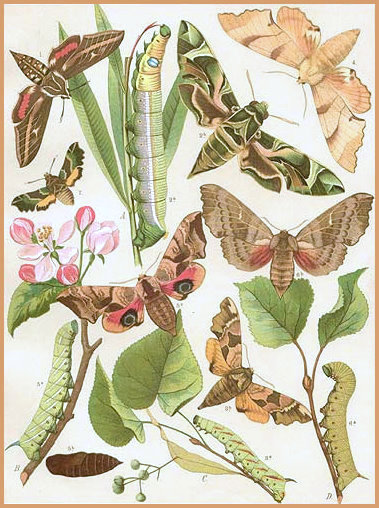
AFGHANISTAN: Ebert, G. (1969, 1974); Daniel, F. (1963, 1971).
ALBANIA: Rebel, H. & Zerny, H. (1934); Eichler, F. & Friese, G. (1965).
ALGERIA: Rothschild, W. (1917); Speidel, W. & Hassler, M. (1989).
ARMENIA: Derzhavets, Yu. A. (1984).
AUSTRIA: Hoffmann, F. & Klos, R. (1914).
AZERBAIJAN: Derzhavets, Yu. A. (1984).
AZORES: Meyer, M. (1991).
BAHRAIN: Walker, D. H. & Pittaway, A. R. (1987).
BALEARIC ISLANDS: Rebel, H. (1926, 1934).
BELARUS: Merzheevskaya, I., Litvinova, A. N. & Molchanova, R. V. (1976); Derzhavets, Yu. A. (1984).
BELGIUM: Herbulot, C. (1971).
BULGARIA: Ganev, J. (1984).
CANARY ISLANDS: van der Heyden, T. (1990, 1991)
CAPE VERDE ISLANDS: Bauer, E. & Traub, B. (1980).
CHINA: Chu, H. F. & Wang, L. Y. (1980b).
CORSICA: Mann, J. (1855); Bretherton, R. F. & Worms C. G. M. de (1963); Rungs, C. E. (1977, 1988).
CZECHOSLOVAKIA [Czechia and SLOVAKIA]: Komarek, O. & Tykac, J. (1952); Hruby, K. (1964).
DENMARK: Nordstroem, F. (1955); Hoffmeyer, S. (1960); Nordstroem, F., Opheim, M. & Sotavalta, O. (1961).
EGYPT: Badr, M. A., Oshaibah, A. A., Nawabi, A. El- & Gamal, M. M. Al- (1985).
ESTONIA: Petersen, W. (1924); Thomson, E. (1967).
FINLAND: Seppaenen, E. J. (1954); Nordstroem, F. (1955); Nordstroem, F., Opheim, M. & Sotavalta, O. (1961).
FRANCE: Rondou, J.-P. (1903); Frionnet, M. C. (1910); Herbulot, C. (1971); Feltwell, J. & Ducros, P. (1989).
GEORGIA: Derzhavets, Yu. A. (1984).
GERMANY: Heinemann, H. von (1859); Bergmann, A. (1953); Forster, W. & Wohlfahrt, T. A. (1960).
GREAT BRITAIN: Buckler, W. (1887); Barrett, C. G. (1893); Lucas, W. J. (1895); Kirby, W. F. (1897, c 1910); Tutt, J. W. (1902, 1904); South, R. (1907, 1961); Newman, L. H. (1965); Heath, J. & Skelton, M. J. (1973); Gilchrist W. L. R. E. (1979); Skinner, B. (1984); Easterbrook, M. (1985).
GREECE: Koutsaftikis, A. (1970, 1973, 1974).
HUNGARY: Abafi-Aigner, L., Pavel, J. & Uhryk, F. (1896); Kovacs, L. (1953).
ICELAND: Wolff. N. L. (1971).
IRAN: Bienert, T. (1870); Watkins, H. T. G. & Buxton, P. A. (1923); Brandt, W. (1938); Sutton, S. L. (1963); Barou, J. ([1967]); Daniel, F. (1963, 1971); Ebert, G. (1976); Kalali, Gh.-H. (1976).
IRAQ: Boulenger, G. A. et. al. ([1923]); Watkins, H. T. G. & Buxton, P. A. (1923); Wiltshire, E. P. (1957).
IRELAND: Heath, J. & Skelton, M. J. (1973); Gilchrist, W. L. R. E., (1979); Skinner, B. (1984); Lavery, T. A. (1991).
ISRAEL: Eisenstein, I. (1984).
ITALY: Senna, A. (1912); Herbulot, C. (1971); Storace, L. (1993).
KASHMIR: Bell, T. R. D. & Scott, F. B. (1937).
KAZAKHSTAN: Derzhavets, Yu. A. (1984).
KUWAIT: Walker, D. H. & Pittaway, A. R. (1987).
KYRGYZSTAN: Derzhavets, Yu. A. (1984).
LEBANON: Zerny, H. (1933); Ellison, R. E. & Wiltshire, E. P. (1939).
LITHUANIA: Kazlauskas, R. (1984).
MADEIRA: Baker, G. T. (1891); Cockerell, T. D. A. (1923); Gardner, A. E. & Classey, E. W. (1960); Worms, C. G. M. de (1964).
MALTA: Valetta, A. (1973).
MOROCCO: Rothschild , W. (1917); Zerny, H. (1936); Rungs, C. E. (1981).
NETHERLANDS: Lempke, B. J. (1937); Meerman, J. C. (1987).
NORWAY: Nordstroem, F. (1955); Nordstroem, F., Opheim, M. & Sotavalta, O. (1961).
OMAN: Wiltshire, E. P. (1975a,b).
PAKISTAN: Bell, T. R. D. & Scott, F. B. (1937).
PORTUGAL: Gomez Bustillo, M. R. & Fernandez-Rubio, F. (1976).
QATAR: Walker, D. H. & Pittaway, A. R. (1987).
ROMANIA: Fleck, E. (1901); König, F. (2003).
RUSSIA: Alpheraky, S. (1882); Grum-Grshimailo, G. E. (1890); Kumakov, A. P. (1977); Derzhavets, Yu. A. (1984).
SAUDI ARABIA: Pittaway, A. R. (1979b, 1981, 1987); Walker, D. H. & Pittaway, A. R. (1987); Wiltshire, E. P. (1980a, 1986, 1990).
SICILY: Mina-Palumbo, F. & Failla-Tedaldi, L. (1889); Mariani, M. (1939).
SPAIN: Gomez Bustillo, M. R. & Fernandez-Rubio, F. (1974, 1976); Lacasa, A., Garrido, A., Rivero, J. M. et al. (1979); Gomez Bustillo, M. R. & Mendez Garnica, J. M. (1981); Perez Lopez, F. J. (1989).
SWEDEN: Nordstroem, F. (1955); Nordstroem, F., Opheim, M. & Sotavalta, O. (1961).
SWITZERLAND: Heinemann, H. von (1859); Frey, H. (1880); Vorbrodt, K. & Mueller-Rutz, J. (1911); Herbulot, C. (1971).
SYRIA: Hariri, G. El- (1971).
TAJIKISTAN: Grum-Grshimailo, G. E. (1890); Shchetkin, Yu. L. (1949); Derzhavets, Yu. A. (1984).
TUNISIA: Rothschild, W. (1917).
TURKEY: Staudinger, O. ([1879]--1881); Daniel, F. (1932, 1939); Rebel, H. (1933); Freina, J. J. de (1979).
TURKMENISTAN: Myartzeva, S. N. & Tokeaew, R. T. (1972); Tashliev, A. O. (1973); Derzhavets, Yu. A. (1984).
UKRAINE: Derzhavets, Yu. A. (1984); Efetov, K. A. & Budashkin, Yu. I. (1990).
UNITED ARAB EMIRATES: Walker, D. H. & Pittaway, A. R. (1987).
UZBEKISTAN: Grum-Grshimailo, G. E. (1890); Derzhavets, Yu. A. (1984).
YUGOSLAVIA [BOSNIA & HERZEGOVINA, CROATIA, MACEDONIA, SLOVENIA, SERBIA and MONTENEGRO]: Daniel, F., Forster, W. & Osthelder, L. (1951); Andus, L. (1986).
 Return to species list
Return to species list